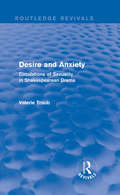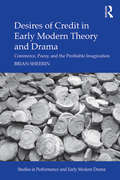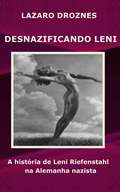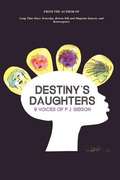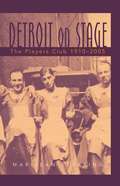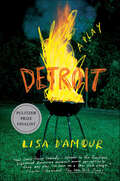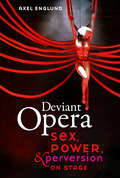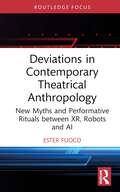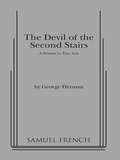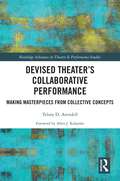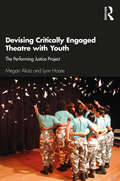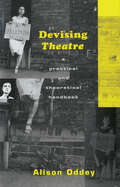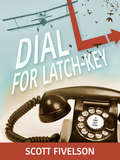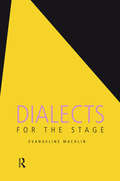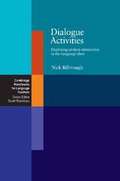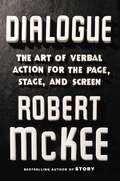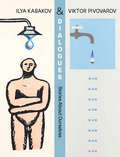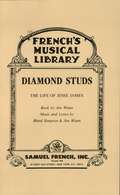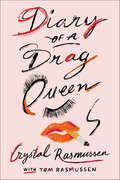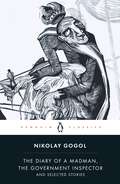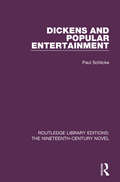- Table View
- List View
Desire and Anxiety: Circulations of Sexuality in Shakespearean Drama (Routledge Revivals)
by Valerie TraubIn both feminist theory and Shakespearean criticism, questions of sexuality have consistently been conflated with questions of gender. First published in 1992, this book details the intersections and contradictions between sexuality and gender in the early modern period. Valerie Traub argues that desire and anxiety together constitute the erotic in Shakespearean drama – circulating throughout the dramatic texts, traversing ‘masculine’ and ‘feminine’ sites, eliciting and expressing heterosexual and homoerotic fantasies, embodiments, and fears. This is the first book to present a non-normalizing account of the unconscious and the institutional prerogatives that comprise the erotics of Shakespearean drama. Employing feminist, psychoanalytic, and new historical methods, and using each to interrogate the other, the book synthesises the psychic and the social, the individual and the institutional.
Desires of Credit in Early Modern Theory and Drama: Commerce, Poesy, and the Profitable Imagination (Studies in Performance and Early Modern Drama)
by Brian SheerinDesires of Credit in Early Modern Theory and Drama traces the near-simultaneous rise of economic theory, literary criticism, and public theater in London at the turn of the seventeenth century, and posits that connecting all three is a fascination with creating something out of nothing simply by acting as if it were there. Author Brian Sheerin contends that the motivating force behind both literary and economic inquiry at this time was the same basic quandary about the human imagination--specifically, how investments of belief can produce tangible consequences. Just as speculators were realizing the potency of collective imagination on economic circulation, readers and dramatists were becoming newly introspective about whether or not the 'lies' of literature could actually be morally 'profitable.' Could one actually benefit by taking certain fictions 'seriously'? Each of the five chapters examines a different dimension of this question by highlighting a particular dramatization of economic trust on the Renaissance stage, in plays by Marlowe, Shakespeare, Heywood, Dekker, and Jonson. The book fills a gap in current scholarship by keeping economic and dramatic interests rigorously grounded in early modern literary criticism, but also by emphasizing the productive nature of debt in a way that resonates with recent economic sociology.
Desnazificando Leni
by Lázaro Droznes Daniela CäsarEsta ficção dramática recria o julgamento de Leni Riefenstahl, levado adiante pelo Comitê de Desnazificação dos Aliados com o objetivo de determinar seu grau de responsabilidade nos crimes nazistas, e como parte de uma campanha de desnazificação realizada na Alemanha pós-guerra. Diversas cenas dos seus documentários são usadas como evidência contra ela, alegando-se que foram utilizadas como ferramentas de propaganda do regime. Leni defende sua independência e autonomia como artista. No decorrer do julgamento, surge como tema a relação entre os artistas e o poder, a necessidade de desenvolver uma carreira artística que não dependa do poder político e a possibilidade de criar arte por meio da própria arte. Uma arte que justifique a si mesma.
Destiny's Daughters: 9 Voices Of P. J. Gibson
by P. J. GibsonFor all serious connoisseurs of quality theatre and exceptional writing, this anthology abounds with superb characterization and brilliant plots, great reading and fodder for serious actors, directors, and producers. (Plays/Drama)
Detroit on Stage: The Players Club, 1910-2005 (Great Lakes Books Series)
by Marijean LeveringFounded in 1910, Detroit’s Players Club is an all-male club devoted to the production of theater by members for other members’ enjoyment. Called simply "The Players," members of the club design, direct, and act in the shows, including playing the female roles. In Detroit on Stage, Marijean Levering takes readers behind the scenes of the club’s private "frolics" to explore the unique history of The Players, discover what traditions they still hold dear, and examine why they have survived relatively unscathed through changes that have shuttered older and more venerable institutions. The Players developed during a nationwide vogue for community and art theater and also as Detroit’s auto elites were in the midst of forming new private clubs to add to their own sense of prestige. By the 1920s, The Players had built their own playhouse and established most of their significant traditions, including the monthly frolics, at which the members perform for each other. At the frolics, members in the audience would wear tuxedos and drink beer out of personalized mugs, customs that remain to this day. Prominent Detroiters have always been among the ranks of the Players, and several well-known auto industry figures were members from the beginning, including banker Henry B. Joy, Oldsmobile sales manager Roy D. Chapin, and Ford executives James Couzens and Edsel Ford. Over the decades that followed the club’s founding, its membership and traditions have remained strong despite major world events that shook Detroit such as Prohibition, the Great Depression, and World War II. In looking at The Players of today, Levering explores the camaraderie and sense of history that has kept the club together and relatively unchanged throughout the years. She also examines the club’s notable members and its unique place in Detroit history. Detroit on Stage places The Players club in the broader contexts of social clubs, explaining how these organizations originate and function. Readers interested in Detroit cultural history and theater studies will enjoy this rare glimpse inside a long-standing Detroit cultural institution.
Detroit: A Play
by Lisa D'AmourIn a "first ring" suburb outside a midsize American city, Ben and Mary fire up the grill to welcome the new neighbors who've moved into the long-empty house next door. The fledgling friendship soon veers out of control, shattering the fragile hold that newly unemployed Ben and burgeoning alcoholic Mary have on their way of life—with unexpected comic consequences. Detroit is a fresh, offbeat look at what happens when we dare to open ourselves up to something new. After premiering at Chicago's Steppenwolf Theatre last year to rave reviews, Lisa D'Amour's brilliant and timely play moves to Broadway this fall.
Deviant Opera: Sex, Power, and Perversion on Stage
by Axel EnglundImagine Armida, Handel’s Saracen sorceress, performing her breakneck coloraturas in a black figure-hugging rubber dress, beating her insubordinate furies into submission with a cane, suspending a captive Rinaldo in chains from the ceiling of her dungeon. Mozart’s peasant girl Zerlina, meanwhile, is tying up and blindfolding her fiancé to seduce him out of his jealousy of Don Giovanni. And how about Wagner’s wizard, Klingsor, ensnaring his choir of flower maidens in elaborate Japanese rope bondage? Opera, it would appear, has developed a taste for sadomasochism. For decades now, radical stage directors have repeatedly dressed canonical operas—from Handel and Mozart to Wagner and Puccini, and beyond—in whips, chains, leather, and other regalia of SM and fetishism. Deviant Opera seeks to understand this phenomenon, approaching the contemporary visual code of perversion as a lens through which opera focuses and scrutinizes its own configurations of sex, gender, power, and violence. The emerging image is that of an art form that habitually plays with an eroticization of cruelty and humiliation, inviting its devotees to take sensual pleasure in the suffering of others. Ultimately, Deviant Opera argues that this species of opera fantasizes about breaking the boundaries of its own role-playing, and pushing its erotic power exchanges from the enacted to the actual.
Deviations in Contemporary Theatrical Anthropology: New Myths and Performative Rituals between XR, Robots and AI (ISSN)
by Ester FuocoThis book refers to the artistic deviation from dominant goals in a social system or from means considered legitimate in that system.This book explores a "New Humanism" in the performing arts, unique in the sense of human's ability to co-create and communicate beyond spatial and temporal boundaries, wars, and pandemics, through artistic deviations carried out by machines and through the Extended Reality. Through the lens of anthropology and aesthetics, this study selects useful case studies to demonstrate this phenomenon of performative symphonises, in which the experimentation of AI-driven creativity and the new human-robot interaction (HRI) lead to philosophical inquiries about the nature of creativity, intelligence, and the definition of art itself. These shifts in paradigms invite us to reconsider established concepts and explore new perspectives on the relationship between technology, art, and the human experience.This book will be of great interest to students and scholars in theatre and performance studies, anthropology, and digital humanities.
Devil Of The 2Nd Stairs
by George HermanA remote priory is the center for local missionary activity. It is winter and the nuns are preparing for the burial of a deceased sister. As they are singing the Miserere, a warm wind rushes through the chapel and the dead nun sits up in her coffin and laughs! Thus begins for the community of nuns a week of terror, voodoo, suspicion, diabolical possession and attendant horrors.
Devised Theater’s Collaborative Performance: Making Masterpieces from Collective Concepts (Routledge Advances in Theatre & Performance Studies)
by Telory D ArendellThis book provides a fascinating and concise history of devised theatre practice. As both a founding member of Philadelphia’s Pig Iron Theater Company and a Professor, Telory Arendell begins this journey with a brief history of Joan Littlewood’s Theatre Workshop and Living Newspapers through Brecht’s Berliner Ensemble and Joe Chaikin’s Open Theatre to the racially inflected commentary of Luis Valdez’s Teatro Campesino and Ariane Mnouchkine’s collaboration with Théâtre de Soleil. This book explores the impact of devised theatre on social practice and analyzes Goat Island’s use of Pina Bausch’s gestural movement, Augusto Boal’s Theatre of the Oppressed in Giving Voice, Anna Deavere Smith’s devised envelope for Verbatim Theatre, The Tectonic Theatre Project’s moment work, Teya Sepinuck’s Theatre of Witness, Pig Iron’s use of Lecoq mime to build complex physical theatre scripts, and The Riot Group’s musical arrangement of collaborative devised text. Included are a foreword by Allen J. Kuharski and three devised plays by Theatre of Witness, Pig Iron, and The Riot Group. Replete with interviews from the initial Pig Iron collaborators on subjects of writing, directing, choreographing, teaching, and developing a pedagogical platform that supports devised theatre.
Devising Critically Engaged Theatre with Youth: The Performing Justice Project
by Megan Alrutz Lynn HoareDevising Critically Engaged Theatre with Youth: The Performing Justice Project offers accessible frameworks for devising original theatre, developing critical understandings of racial and gender justice, and supporting youth to imagine, create, and perform possibilities for a more just and equitable society. Working at the intersections of theory and practice, Alrutz and Hoare present their innovative model for devising critically engaged theatre with novice performers. Sharing why and how the Performing Justice Project (PJP) opens dialogue around challenging and necessary topics already facing young people, the authors bring together critical information about racial and gender justice with new and revised practices from applied theatre, storytelling, theatre, and education for social change. Their curated collection of PJP "performance actions" offers embodied and reflective approaches for building ensemble, devising and performing stories, and exploring and analyzing individual and systemic oppression. This work begins to confront oppressive narratives and disrupt patriarchal systems—including white supremacy, racism, sexism, and homophobia. Devising Critically Engaged Theatre with Youth invites artists, teaching artists, educators, and youth-workers to collaborate bravely with young people to imagine and enact racial and gender justice in their lives and communities. Drawing on examples from PJP residencies in juvenile justice settings, high schools, foster care facilities, and community-based organizations, this book offers flexible and responsive ways for considering experiences of racism and sexism and performing visions of justice. Visit performingjusticeproject.org for additional information and documentation of PJP performances with youth.
Devising Theatre: A Practical and Theoretical Handbook
by Alison OddeyDevising Theatre is a practical handbook that combines a critical analysis of contemporary devised theatre practice with descriptions of selected companies, and suggestions for any group devising theatre from scratch. It is the first book to propose a general theory of devised theatre. After identifying the unique nature of this type of performance, the author examines how devised theatre is perceived by professional practitioners, and provides an historical overview illustrating how it has evolved since the 1960s. Alison Oddey examines the particular working practices and products of a number of professional companies, including a Reminiscence theatre for the elderly and a theatre-in-education group, and offers ideas and exercises for exploration and experimentation.
Dial L for Latch-Key: The Radio Play
by Scott FivelsonShe tried to dial M for murder, but instead she accidentally dialed L for latch-key... A plotting husband who strongly resembles Ray Milland... A framed wife as elegant as Grace Kelly... An Inspector straight out of Monty Python... Hitchcock would be spinning in his grave if he weren't suiting up for his cameo.Suspenseful, witty, and romantic, this one-act play is a lively satire of the films of Alfred Hitchcock.
Dialects for the Stage
by Evangeline MachlinDialect work is one of the actor's most challenging tasks. Need to know a Russian accent? Playing a German countess or a Midwestern farmhand? These and more accents – from Yiddish to French Canadian – are clearly explained in Evangeline Machlin's classic work. Now available in a book-and-CD format, Evangeline Machlin's Dialects for the Stage is based on a method of dialect acquisition she developed during her years working with students at Boston University's Division of Theatre. During her long career, Evangeline Machlin trained such actors as Steve McQueen, Lee Grant, Suzanne Pleshette, Joanne Woodward, and Faye Dunaway.
Dialogue Activities
by Nick BilbroughUsing dialogues in different contexts, this book provides over 100 practical activities for teachers to adapt for their classrooms. These activities encourage learners to look at the English language through dialogues and spoken interaction from coursebooks, literature and media, as well as authentic conversation extracts. The book explores using dialogue to communicate personal meaning effectively. It covers dialogue as both 'product' and 'process' in language teaching and will encourage learners to look beyond conventional communicative strategies and practise spoken language in a fresh contextualised way.
Dialogue: The Art of Verbal Action for Page, Stage, and Screen
by Robert MckeeThe long-awaited follow-up to the perennially bestselling writers' guide Story, from the most sought-after expert in the art of storytelling. Robert McKee's popular writing workshops have earned him an international reputation. The list of alumni with Oscars runs off the page. The cornerstone of his program is his singular book, Story, which has defined how we talk about the art of story creation. Now, in DIALOGUE, McKee offers the same in-depth analysis for how characters speak on the screen, on the stage, and on the page in believable and engaging ways. From Macbeth to Breaking Bad, McKee deconstructs key scenes to illustrate the strategies and techniques of dialogue. DIALOGUE applies a framework of incisive thinking to instruct the prospective writer on how to craft artful, impactful speech. Famous McKee alumni include Peter Jackson, Jane Campion, Geoffrey Rush, Paul Haggis, the writing team for Pixar, and many others.
Dialogues: Ilya Kabakov and Vikor Pivovarov, Stories about Ourselves
by Tomas GlancArtists in the Soviet Union faced a difficult choice: either join the official academies and make art that conformed to the state’s aesthetic and ideological dictates, or attempt to develop alternative artistic practices and spheres for exhibiting their work. In the early 1970s, conceptual artists Ilya Kabakov and Viktor Pivovarov chose the latter option, turning their limited resources into an asset by pioneering an entirely new artistic genre: the album. Somewhere between drawings and novels, Kabakov and Pivovarov’s albums were also the basis for unique performance pieces, as the artists invited select audiences to their Moscow apartments for private readings and viewings of the albums, helping to cultivate an alternative artistic community in the process. This exhibition catalog brings together Kabakov and Pivovarov’s key works for the first time, putting the two artists in dialogue and recreating their artistic community. It not only includes nearly hundred pages of full-color illustrations, but also provides complete English translations of the Russian texts that appear in the volume, plus new interviews with each artist. Taken together, they give viewers a new appreciation of the different aesthetic strategies each artist used to depict the absurdities of everyday life in the Soviet era. Published in partnership with the Zimmerli Museum.
Diamond Studs
by Bland SimpsonSaloon Musical / 13 interchangeable dramatic, musical and vocal roles / A rip roaring country and western rendition of the Jesse James saga that even had New York critics stomping their feet to the music. Jesse James is seen as a frustrated Southerner at the end of the Civil War, hamstrung by Northern limits imposed on the losers' personal freedom. He turns to bank and train robbery, ultimately to be done in by his pal, Bob Ford, for the sake of reward and publicity.
Diary of a Drag Queen
by Crystal Rasmussen Tom Rasmussen“This book changed my life. Tom Rasmussen’s honesty, vulnerability, and fearlessness jump out of every page and every word. It is the queer bible I’ve always needed.” —Sam Smith, singer and songwriter"Tom covers the nuance, doubt, and uncertainty of being a drag queen. Crystal covers the transcendence . . . Charisma and quick intelligence—two qualities that have long been prerequisites for drag . . . Diary puts on technicolor display." —Katy Waldman, The New YorkerIn these pages, find glamour and gaffes on and off the stage, clarifying snippets of queer theory, terrifyingly selfish bosses, sex, quick sex, KFC binges, group sex, the kind of honesty that banishes shame, glimmers of hope, blazes of ambition, tender sex, mad dashes in last night's heels plus a full face of make-up, and a rom-com love story for the ages. This is where the unspeakable becomes the celebrated. This is the diary of a drag queen—one dazzling, hilarious, true performance of a real, flawed, extraordinary life. "I hope people like me will read this and feel seen and loved by it. I hope people who aren't like me will enjoy it, laugh with it, learn from it. And I hope people who don't like me will file lawsuits just so I can wear my brand-new leopard-print skirt suit and bust their asses in court."—Crystal Rasmussen, in Refinery29
Diary of a Madman, The Government Inspector, & Selected Stories
by Nikolay GogolAuthor, dramatist and satirist, Nikolay Gogol (1809-1852) deeply influenced later Russian literature with his powerful depictions of a society dominated by petty beaurocracy and base corruption. This volume includes both his most admired short fiction and his most famous drama. A biting and frequently hilarious political satire, The Government Inspector has been popular since its first performance and was regarded by Nabokov as the greatest Russian play every written. The stories gathered here, meanwhile, range from comic to tragic and describe the isolated lives of low-ranking clerks, lunatics and swindlers. They include Diary of a Madman, an amusing but disturbing exploration of insanity; Nevsky Prospect, a depiction of an artist besotted with a prostitute; and The Overcoat, a moving consideration of poverty that powerfully influenced Dostoevsky and later Russian literature.
Dickens and Popular Entertainment (Routledge Library Editions: The Nineteenth-Century Novel #34)
by Paul SchlickeFirst published in 1985. Dickens was a vigorous champion of the right of all men and women to carefree amusements and dedicated himself to the creation of imaginative pleasure. This book represents the first extended study of this vital aspect of Dickens’ life and work, exploring how he channelled his love of entertainment into his artistry. This study offers a challenging reassessment of Nicholas Nickleby, The Old Curiosity Shop and Hard Times. It shows the importance of entertainment to Dickens’ journalism and presents an illuminating perspective on the public readings which dominated the last twelve years of his life. This book will be of interest to students of literature.
Dictionary of Military Terms: Over 6,000 Words Clearly Defined (Dictionaries Ser.)
by Richard BowyerFirst Published in 2000. Routledge is an imprint of Taylor & Francis, an informa company.
Die Geschwister: Ein Schauspiel in einem Akt
by Johann Wolfgang Von GoetheWilhelm loved the Charlotte widow. Shortly before her death, Charlotte confided her beloved daughter Marianne. William falls in love with the young girl, the image of the deceased, but speaks to anyone about his feelings. Marianne holds Wilhelm for her brother and a future can not imagine without him. Fabrice, a good business friend William, also believes in the myth of the two brothers and makes Marianne court.
Die Leiden des jungen Werther -- Band 1
by Johann Wolfgang Von GoetheMost of The Sorrows of Young Werther is presented as a collection of letters written by Werther, a young artist of a sensitive and passionate temperament, to his friend Wilhelm. These give an intimate account of his stay in the fictional village of Wahlheim (based on Garbenheim, near Wetzlar),[citation needed] whose peasants have enchanted him with their simple ways. There he meets Charlotte, a beautiful young girl who takes care of her siblings after the death of their mother. Werther falls in love with Charlotte despite knowing beforehand that she is engaged to a man named Albert eleven years her senior.[3]
Die Leiden des jungen Werther -- Band 2
by Johann Wolfgang Von GoetheMost of The Sorrows of Young Werther is presented as a collection of letters written by Werther, a young artist of a sensitive and passionate temperament, to his friend Wilhelm. These give an intimate account of his stay in the fictional village of Wahlheim (based on Garbenheim, near Wetzlar),[citation needed] whose peasants have enchanted him with their simple ways. There he meets Charlotte, a beautiful young girl who takes care of her siblings after the death of their mother. Werther falls in love with Charlotte despite knowing beforehand that she is engaged to a man named Albert eleven years her senior.[3]
